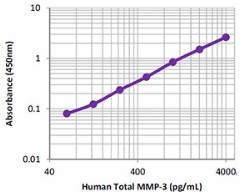- Regulatory Status
- RUO
- Other Names
- Matrix Metalloproteinase 3, Stromelysin 1, Progelatinase, Proteoglycanase, Transin-1, MMP3
- Ave. Rating
- Submit a Review
- Product Citations
- publications

Matrix Metalloproteinase 3 (MMP-3), also known as Matrix Metallopeptidase 3, Stromelysin 1, Progelatinase, Proteoglycanase, or Transin-1, is a member of a broad family of MMPs, which are zinc-dependent enzymes that break down extracellular matrix proteins as part of their primary functions. MMP-3 is secreted in its 54 kD inactive pro-enzyme form from many cell types including fibroblasts, chondrocytes, endothelial cells, macrophages, vascular smooth muscle cells, osteoblasts, and keratinocytes. A cysteine residue in the pro-domain coordinates with the zinc in the catalytic domain to maintain latency. MMP-3 is activated by proteolytic proteins and compounds including MMP-7, 4-aminophenylmercuric acetate (APMA), and trypsin. Alpha macroglobulins and tissue inhibitor of metalloproteinase 1 (TIMP-1) are the primary natural inhibitors of MMP-3 that can regulate its activation and hinder its function. Activated MMP-3 degrades several forms of collagen, proteoglycan, fibronectin, laminin, and elastin.
Human MMP-3 shares significant amino acid sequence identity with MMP-3 from other species, including 85-99%, 83%, 81%, 77%, and 75% from non-human primates, bovine, equine, mouse, and rat, respectively.
MMP-3 is involved in tissue remodeling processes such as embryonic development, reproduction, morphogenesis, and angiogenesis. MMP-3 is a potential biomarker for many disease conditions, as it plays important roles in tumor growth, invasion, and metastasis. Additionally, MMP-3 activates several other MMP proteins by cleavage of the proenzyme domain.
The LEGEND MAX™ Human Total MMP-3 Sandwich Enzyme-Linked Immunosorbent Assay (ELISA) kit includes a 96-well strip plate that is pre-coated with a goat polyclonal anti-human MMP-3 antibody. The Detection Antibody is a biotinylated goat polyclonal anti-human MMP-3 antibody. This kit is specifically designed to accurately measure MMP-3, including Pro MMP-3, Mature MMP-3, and Mature MMP-3/TIMP-1 complex. This kit has been analytically validated to assess cell culture supernatant, serum, and heparin plasma samples with ready-to-use reagents.
Kit Details
- Kit Contents
-
- Anti-human Total MMP-3 Pre-coated 96-well Strip Microplate
- Human Total MMP-3 Detection Antibody
- Human Total MMP-3 Standard
- Avidin-HRP
- Assay Buffer A
- Wash Buffer (20X)
- Substrate Solution F
- Stop Solution
- Plate Sealers
- Materials Not Included
-
- Microplate reader able to measure absorbance at 450 nm
- Adjustable pipettes to measure volumes ranging from 1 µL to 1,000 µL
- Deionized water
- Wash bottle or automated microplate washer
- Log-Log graph paper or software for data analysis
- Tubes to prepare standard dilutions
- Timer
- Plate Shaker
- Polypropylene vials
Product Details
- Verified Reactivity
- Human
- Application
-
ELISA
- Product Citations
-
- Sensitivity
- 21.6 pg/mL ± 18.3 pg/mL
- Standard Range
- 62.5 - 4,000 pg/mL
- Materials Not Included
-
- Microplate reader able to measure absorbance at 450 nm
- Adjustable pipettes to measure volumes ranging from 1 µL to 1,000 µL
- Deionized water
- Wash bottle or automated microplate washer
- Log-Log graph paper or software for data analysis
- Tubes to prepare standard dilutions
- Timer
- Plate Shaker
- Polypropylene vials
Antigen Details
- Biology Area
- Angiogenesis, Cell Adhesion, Cell Biology, Neuroinflammation, Neuroscience
- Molecular Family
- Enzymes and Regulators
- Gene ID
- 4314 View all products for this Gene ID
- UniProt
- View information about MMP-3 on UniProt.org
Related Pages & Pathways
Pages
Related FAQs
- In your LEGEND MAX™ ELISA Kits, there is a step that calls for washing the plates before adding sample. What is the purpose of this step?
-
We typically use a stabilizer for pre-coated plates. The additional washing step is designed to remove these components before you start the assay. If you do not perform the washing, the effect on assay performance is negligible.
- I have multiple LEGEND MAX™ ELISA kits that I want to run simultaneously. Can I use the same wash buffer for all the kits?
-
The wash buffer provided in all our LEGEND MAX™ kits is the same and the part numbers on the wash buffer bottles in these kits should be identical. For ELISA MAX™ Deluxe and ELISA MAX™ Standard Sets, we provide a recipe for the wash buffer on each kit’s technical data sheet. This recipe is the same for all ELISA MAX™ sets.
- For some of your ELISA kits, why do my serum samples require dilution with assay buffer?
-
In some cases, dilution with assay buffer is required to minimize the matrix difference between the samples and the standards to achieve better accuracy.









Follow Us